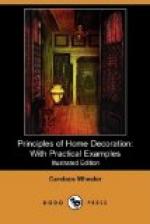It is a curious fact, also, that where a house is surrounded by myriads of small natural forms of leaves and flowers and grasses, plain spaces of colour in interiors, or spaces where form is greatly subordinated to colour, are more grateful to the eye than prominently decorated surface. A repetition of small natural forms like the shells and sea-mosses, which are for the most part hidden under lengths of liquid blue, is pleasing and suggestive by the sea; but in the country, where form is prominent and positive and prints itself constantly upon both mental and bodily vision, unbroken colour surfaces are found to be far more agreeable.
It will be seen that the principles of appropriate furnishing and adornment in house interiors depend upon circumstances and natural surroundings as well as upon the character and pursuits of the family who are to be lodged, and that the final charm of the home is attained by a perfect adaptation of principles to existing conditions both of nature and humanity.
In cottages of the character we are considering, furniture should be simpler and lighter than in houses intended for constant family living. Chairs and sofas should be without elaborate upholstery and hangings, and cushions can be appropriately made of some well-coloured cotton or linen material which wind, and sun, and dampness cannot spoil, and of which the freshness can always be restored by laundering. These are general rules, appropriate to all summer cottages, and to these it may be added, that a house which is to be closed for six or eight months in the year should really, to be consistent, be inexpensively furnished. These general rules are intended only to emphasise the fact that in houses which are to become in the truest sense homes—that is, places of habitation which represent the inhabitants, directions or rules for beautiful colour and arrangement of interiors, must always follow the guiding incidents of class and locality.
CHAPTER X
CEILINGS
As ceilings are in reality a part of the wall, they must always be considered in connection with room interiors, but their influence upon the beauty of the average house is so small, that their treatment is a comparatively easy problem.
In simple houses with plaster ceilings the tints to be used are easily decided. The rule of gradation of colour from floor to ceiling prescribes for the latter the lightest tone of the gradation, and as the ceiling stands for light, and should actually reflect light into the room, the philosophy of this arrangement of colours is obvious. It is not, however, an invariable rule that the ceiling should carry the same tint as the wall, even in a much lighter tone, although greater harmony and restfulness of effect is produced in this way. A ceiling of cream white will harmonise well with almost any tint upon the walls, and at the same time give an effect of air and light in the room. It is also a good ground for ornament in elaborately decorated ones.




